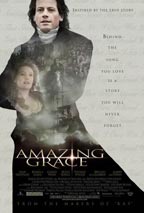Michael Pitt I Origins
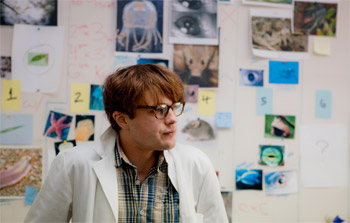
Michael Pitt I Origins
Cast: Michael Pitt, Steven Yeun, Astrid Bergès-Frisbey
Director: Mike Cahill
Genre: Drama, Sci-Fi
Rated: MA
Running Time: 107 minutes
Synopsis: I Origins, the second feature film from writer and director Mike Cahill, tells the story
of Dr. Ian Gray (Michael Pitt), a molecular biologist studying the evolution of the eye. He finds his work permeating his life after a brief encounter with an exotic young woman (Astrid Bergès- Frisbey) who slips away from him. As his research continues years later with his lab partner Karen (Brit Marling), they make a stunning scientific discovery that has far reaching implications and complicates both his scientific and spiritual beliefs. Traveling half way around the world, he risks everything he has ever known to validate his theory. .
I Origins
About The Production
Writer and director Mike Cahill calls his second feature film, I Origins, both a molecular-biology thriller and a love story.
'For generations, the eyes have been called the windows to the soul," explains Mike Cahill. 'Think about it," he says. 'We each possess these magnificent artworks on the front of our face. They are all beautiful, if you look very closely at them. In 1987 a professor at Cambridge University named John Daugman gave that poetic belief a basis in science when he discovered that each human being has a unique and measurable iris pattern, not unlike a fingerprint." From a scientific point of view, the eye is an intricate, complex machine. Says Mike Cahill: 'It has an iris, a pupil, a retina, an optic nerve, sclera and various muscles. Each has specialised functions and work together seamlessly."
Like Mike Cahill's first film, 2011 Sundance Film Festival winner Another Earth, I Origins is a personal and unconventional exploration of the mysteries of the scientific world.
To Mike Cahill, scientists are important role models for filmmakers. 'They spend their lives asking the big questions," he explains. 'Why are we here? What are we made of? They explore the minutest levels of matter and they look at the biggest things, like the universe. I wish I were a scientist, but I'm a filmmaker, so I make films about scientists."
I Origins' protagonist, Dr. Ian Gray (Michael Pitt), is a molecular biologist who studies the evolution of the eye. Mike Cahill says Gray's character is based very loosely on Richard Dawkins, the famed evolutionary biologist and atheist. 'Ian is a researcher whose work leads him to question his beliefs on science and spirituality. When we first meet him, he believes in proof; he believes in data. Spirituality is guided by faith, which is the belief in something without evidence."
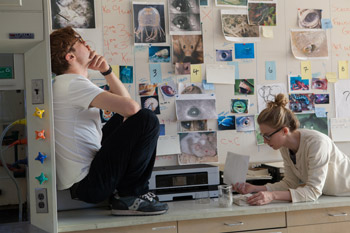 At a late-night party, Ian meets a mysterious masked woman with magnificent eyes, but after their brief encounter, she disappears before he can get her name. A little detective work and a series of extraordinary coincidences lead Ian back to the young woman, whose name, he discovers, is Sofi.
At a late-night party, Ian meets a mysterious masked woman with magnificent eyes, but after their brief encounter, she disappears before he can get her name. A little detective work and a series of extraordinary coincidences lead Ian back to the young woman, whose name, he discovers, is Sofi. 'The way he finds her has everything to do with her eyes," says Mike Cahill. 'It feels magical when it happens, but it involves both science and intuition. Sofi turns out to be totally different from Ian. She's a wild child, a free spirit. But opposites attract and they have an intense romance."
Since Daugman's early groundbreaking work at Cambridge, iris-recognition systems have been developed that can photograph the human eye and generate a unique 12-digit code to describe them. Once a far-fetched element in science fiction films like Minority Report, the technology is now a reality used in airports and passport facilities, by the military, and even by private corporations including Google.
'When you travel through Heathrow Airport, you can now go through the fast lane if you've had your eye scanned," says Mike Cahill. 'In some hospitals, they scan newborn babies' eyes.
It's like a fingerprint, but you don't have to touch ink. Everyone has his or her own unique iris. In the film, we've taken iris-recognition a step further, which I think is pretty compelling." The eye's complexity has sparked an impassioned debate between people with a scientific bent and those who rely more on religious faith. Richard Behe, a prominent biochemist and creationist, has argued that the eye is irreducibly complex. It is too specific in its structure to be explained by evolution and therefore is proof of intelligent design"and the existence of God.
Others, including Richard Dawkins, have proposed that a fully functioning human eye could have evolved from light sensitive cells through mutations over centuries. 'The character of Ian is trying to demonstrate real, practical examples of each stage of the eye's evolution," Mike Cahill says. 'If he can, he will have made an unprecedented discovery that he hopes will settle the argument."
I Origins reteams the director with producer Hunter Gray, who produced Another Earth along with Mike Cahill and Marling. 'This script was something Mike Cahill had been talking about for a long time," says Gray. 'It's an amazing story of discovery, science and faith. In most science fiction, there is one facet that takes a leap of faith for the audience. Mike Cahill's greatest ability is to make people wonder if there is a leap of faith, or if the world he has created is real. Once he has people hooked, his own excitement takes over and everyone becomes a believer. Throughout the filmmaking process, from pre-production to post, everyone who touched this film put their hearts into it because Mike Cahill's energy is infectious."
Producer Alex Orlovsky, Gray's partner in production company Verisimilitude, adds: 'Mike Cahill has a very special gift. He takes lofty ideas and explores them through compelling, intimate human stories. The phrase -a clear vision' is thrown around quite a bit in the film world, but I think that Mike embodies those words."
According to Alex Orlovsky, at that point the filmmakers planned to make an ultra-low-budget movie, not unlike Another Earth. 'But as our treatment grew into a full-length screenplay, the characters gained depth and gravitas," he says. 'It evolved from a micro-budget project into an appropriately ambitious second film for Mike Cahill."
'My process is to get together with the actors and read the script through," Mike Cahill continues. 'I record that and listen to it over and over to see what feels right. Then I focus in on scenes that feel false and we work on them in rehearsal."
The director points to a crucial scene early in the film in which Ian re-encounters Sofi on a train. 'As I initially scripted it, there was all this dialogue. It became very clear that filming it on a real train was going to be very difficult because of the ambient noise. But working with the actors, I realized it was all subtext anyway. They didn't have to say anything. It was all, appropriately enough, in their eyes. We stripped the whole scene of words and let it play out silently."
Mike Cahill, who produced, directed, edited and wrote Another Earth (as well as being the cinematographer), takes on these four roles again in I Origins but he gives credit to producers Gray and Alex Orlovsky for making the film possible. 'Hunter Gray and Alex Orlovsky are the world's best producers. To say they are passionate about the project is an understatement. They are intelligent, tireless and creatively engaged. Both of them care as much as I do about the final work and that is saying a lot. I trust them completely and I know that finding this partnership early in my career is a great fortune. They consistently make my work better."
In I Origins, Mike Cahill examines the ultimate question. 'What happens after we die? That is at the heart of the film. Our main character believes in facts and data and evidence. The last thing in the world that he believes is that there is an actual soul. But he and lab partner Karen (Brit Marling) discover something that changes that."
'The movie is both a drama and a science-fiction film, but ultimately it's about love and the infinite nature of love," says Mike Cahill. 'I think audiences will take what they wish for or need from the film, but I also want the film to inspire hope and wonder. I often think that the deeper and more precisely we explore the world through science, the closer we will come to what could be understood as a spiritual narrative of life, and I hope that both sides of this are well represented in the film. I want it to inspire conversation."
Scientists And Saints
Casting a character who appears in every scene of a film, as Ian does, is never a simple task, notes Alex Orlovsky. 'We knew I Origins would be defined to a great extent by the casting choice for Ian," he says. 'The truth is, there are very few actors who are capable of carrying a film, and fewer still who make original, unexpected choices in the moment that elevate a character in surprising and thrilling ways. Michael Pitt is one of them. He brings a true independence of spirit and charisma to Ian that is very much his own."
For his part, Michael Pitt was immediately intrigued by Mike Cahill's pitch. 'I just couldn't get the idea out of my head," the actor says. 'Mike Cahill gave me the treatment and we started emailing back and forth furiously. He put the script together in two or three weeks. From the beginning, Mike Cahill had very clear ideas about where he wanted to go."
Perhaps best known for his role as Jimmy Darmody on the HBO series 'Boardwalk Empire," Mike Cahill has been acting professionally since the age of 16, and has built a reputation for his versatility and range. Still, he says, 'I haven't played a character like this before. Ian is pretty straight-laced, whereas I usually play roles that lean toward off-beat. I like a good amount of time for preparation, especially with something like this, since I don't have much of a science background. Mike Cahill's brother is a scientist and he set up some time for Brit Marling and me to meet some people at the Johns Hopkins Medical Center in Baltimore. We talked to the researchers and they let us participate in some of the experiments. It was a really positive experience."
Ian's hope is that his research into the evolution of the eye will impact the ongoing debate between science and spirituality. 'I know it's very common for people to draw a line between the two, but I don't think that line has to be there," says Michael Pitt. 'There is a place in the middle where they can meet. I hope that audiences will question their views after seeing this. When it was screened at Sundance, it really got people talking, which was pretty exciting."
For the role of Sofi, the filmmakers launched an international search. 'The role was wide open from the beginning," says Alex Orlovsky. 'Casting was complicated by two things: We were looking for somebody exotic and not American, and we thought it would be great if, on top of being a fantastic actress, she also had a unique and unforgettable pair of eyes."
Michael Pitt told Mike Cahill about a young woman he'd met in Paris with extraordinary eyes and suggested that they try to track her down. She turned out to be Spanish actress Astrid Bergès-Frisbey, who received the Chopard Trophy for Female Revelation of the Year spotlighting emerging talent at the 2011 Cannes Film Festival. 'Sofi represents the unknown, all the things that Ian can't explain, which are the things that are both the most beautiful and the most frustrating for him," says Michael Pitt. 'Working with Astrid Bergès-Frisbey had to be primal and instinctual. The way they look at each other tells you more than what they say."
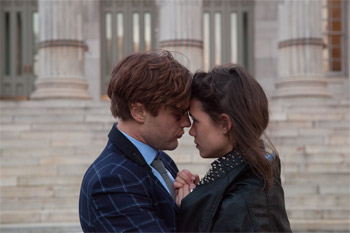 While Mike Cahill had never heard of Astrid Bergès-Frisbey before casting this film, once he met her there was never a doubt that he had found his Sofi.
While Mike Cahill had never heard of Astrid Bergès-Frisbey before casting this film, once he met her there was never a doubt that he had found his Sofi. 'Astrid Bergès-Frisbey's name came up during the casting process," he recalls. 'Sexo de Los Angeles (The Sex of Angels) was playing right next to our office in New York, so I went to see it. I was completely taken by her. She is so compelling on screen. Sofi's presence has to echo through all of the scenes that she is not in and Astrid Bergès-Frisbey has that quality. When she leaves a room, you can still feel her with you."
The actress also possesses an unusual characteristic thatMike Cahill had already incorporated into the character. Sofi and Astrid Bergès-Frisbey both have sectoral heterochromia, a rare genetic mutation that creates irises of multiple colors. 'What you see in the film are Astrid Bergès-Frisbey's real eyes," Mike Cahill says. 'The inner part is brown, the outer part is this greenish grey-blue and they have specks and spots of different colors. I wrote the character to have that quality. When I saw Astrid Bergès-Frisbey's eyes, I knew it was meant to be."
Astrid Bergès-Frisbey, who had been looking forward to taking a long-anticipated break from making films when she received Mike Cahill's script, considered passing without even reading it.
'But once I started, I couldn't stop," she says. 'I was so moved by the story, the intensity and the complexity of it. One of the most interesting elements to me was the idea that you can have two great love stories in your life and they can be completely different, but equally powerful."
Mike Cahill and Astrid Bergès-Frisbey made an immediate connection during their initial meeting via Skype. 'We spent two hours talking about science and life and spirituality," says the actress.
'Mike Cahill has a very special energy. He is so passionate about what he does that you fall in love with him. He is actually very knowledgeable about science and can talk about it for hours. But at the same time, he's a very spiritual person. The movie is a lot like him in that it's about the connections between the two ways of looking at the world."
The actress arrived in New York just 10 days before shooting began and was thrown into an intense rehearsal period. 'I was so anxious because I had not spoken English for two years," she says. 'It was a very small amount of time to prepare. We worked a lot, rewriting, changing the dialogue and making the scenes even more real and more intense."
Despite the pressures of the shoot, Astrid Bergès-Frisbey says she is extremely grateful for the experience. 'I have no words to express it. Mike Cahill likes to improvise a lot and to be able to do that, I had to trust the other actors and feel comfortable with my director. Michael Pitt is such a hard worker. I have never worked with an actor that gave so much."
The other love in Ian's life is Karen, played by Brit Marling, who is his research partner and eventually his wife. 'Sofi and Karen are opposite sides of the same coin," says Mike Cahill. 'Sofi believes in things that sound very -New Age-y' from Ian's perspective. But he is attracted to her because she has a deep embedded intelligence within the context of her spirituality. She may not have read the same books Ian has, but her understanding of the world has validity."
Karen, on the other hand, pursues knowledge as fervently as Sofi follows intuition. 'It's quite romantic, in its own way," says Mike Cahill. 'The greatest thrill for Karen is the night after a discovery, when she's lying in bed, the only person on the planet to know this truth. She loves being on the cutting edge of human knowledge. 'The role is deceptively tricky," he continues.
'When I was writing it, I was thinking, how do we make the pursuit of knowledge seductive? And I thought, Brit Marling!"
In much the same way that it felt inevitable Michael Pitt would play Ian, Brit Marling was the filmmakers' only choice for Karen, according to Alex Orlovsky. 'She has the innate intelligence, the subtle charisma and beauty, that the character required. She also has a history of collaborating with Mike Pitt."
Brit Marling and Mike Cahill, who met as undergrads at Georgetown University, have been creative partners for more than a decade. Brit Marling played the lead role in Mike Cahill's feature directing debut, Another Earth. 'Working with Brit Marling is a true pleasure," says Mike Cahill. 'She's super talented and hardworking. When you're creating art, you hope to find partners you can rely on, and she's someone I want to work with for the rest of my life."
As longtime creative partners, Brit Marling and Mike Cahill have developed their own unique collaborative process. 'We pitch each other ideas and run in weird directions with them," says Brit Marling. 'So I knew that this was a story that Mike Cahill had wanted to tell for a long time. The movie really is a meditation on faith and science. Are those things disconnected from one another, or are they expressions of the same things?"
The dynamic between Karen and Ian is radically different than it is between Sofi and him. 'Mike Cahill and I were interested in the idea of a marriage that has real equality," says Brit Marling. 'Karen is not the assistant-slash-wife. This is a relationship between two people who are equally matched and encourage each other in beautiful, positive ways. They have a lot in common.
With Sofi, there's a real divide. Mike Cahill does an incredible job portraying two very different kinds of love and not judging one or the other as better."
Mike Cahill concurs: 'The two relationships are nothing like each other. Karen is a true partner to Ian. They know and understand each other on many levels. Brit Marling's really an amazing actress, so it it was really fun to watch her build this character. You could see the wheels in her head turning as the character slowly came alive. Every day we worked together was a pleasure."
Brit Marling sees similarities in her working relationship with Mike Cahill and the lab partnership between Ian and Karen. 'I've loved Michael Pitt's work for such a long time," says the actress.
'You can feel from his performances that he really takes the work seriously. He wanted to do each scene 50 times, pushing it to the next level. I feel like we left no stone unturned. 'And Mike Cahill kept it all grounded and in a frame," she adds. 'He creates a magic soap bubble for the actors where it is quiet and still and beautiful. Then he'll whisper something to each of us and the scene will come together. You know how they say some people were born to direct? Mike was born to do this job."
Ian's best friend Kenny, played by Steven Yeun, is a brilliant programmer who works for a company that has amassed a database of iris biometric profiles. While he and Ian studied together, Kenny is more concerned with cashing in on a practical application of the science than the pursuit of pure knowledge, according to Yeun.
'Kenny becomes entrenched in iris biometrics because it's going to make a ton of money for him," says Steven Yeun. 'But he ends up being pivotal in the discovery Ian is about to make. He offers his help expecting one thing and then realizes that everything that he thought, all the research and all the technology that's been built, is being called into question."
Steven Yeun's character often provides a humorous counterpoint to the films more dramatic scenes, a quality which comes naturally to Yeun, according to his co-stars. 'Steven Yeun was so up for everything," says Brit Marling. 'He provides a lightness and sense of humor that the film needs, because it's dealing with so many intense things, Steven comes in as just an amazing breath of fresh air."
'On and off the set, Steven Yeun gave off an energy that drew people to him," says Ian Gray. 'He stole the show with comedy in this film, but he can do anything and I am sure he will in the future."
Yeun, who stars as Glenn Rhee in the hit television drama 'The Walking Dead," initially got involved in the project based on his admiration for Mike Cahill's Another Earth. 'I think there's a great deal in life that is unexplained," he says. 'There is the sense of inner connectivity that we have as human beings. We're all woven into each other's lives. People want concrete evidence to explain why, but we don't have it. What if our souls do recycle themselves in some sense?"
I Origins' climactic third act takes place in Delhi, India, where Mike Cahill brought in British-born actress Archie Panjabi to play Priya Varma. An Indian woman running a community center in the slums of Delhi, it is Priya who helps Ian finally find what he is searching for.
'Archie's humanity is absolutely beautiful," says Mike Cahill. 'Her spirit is so warm. She brought an approach to the character that is bulletproof and full of heart. It was just a privilege to be able to work with her."
'Archie is just wonderful in this film," agrees Michael Pitt. 'She has a quiet strength to her. Her performance is very subtle, but she had all these things going on underneath the surface that were really inspiring for me."
It wasn't until the filmmakers reached Delhi that Mike Cahill completed casting. An epic search was launched to select a little girl to play the role of Salomina, a youngster Ian hopes will provide the key to the mystery he so badly wants to unravel. Indian casting director Dilip Shankar screened more than 1,400 hopefuls for the part.
Initially, the search was focused on Indian-American girls in and around the New York metropolitan area. But MikeCahill and the producers quickly realised that they weren't going to find a believable young actress there. 'Everyone who came in was too Americanized to feel authentic," says Alex Orlovsky.
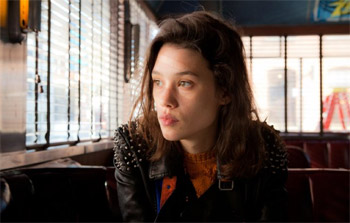 'Ultimately, we found the marvelous Kashish, a young girl from the Salaam Baalak orphanage in Delhi," says Mike Cahill.
'Ultimately, we found the marvelous Kashish, a young girl from the Salaam Baalak orphanage in Delhi," says Mike Cahill. 'Kashish has an astounding energy and spirit that radiates on and off screen. She is completely natural and unselfconscious in front of the camera, as if it doesn't exist. When we found Kashish, I knew we had a movie."
The child not only had never acted before, she had very limited knowledge of English, but Michael Pitt says she is a naturally talented actor. 'Essentially it's all about pretending," he notes. 'Kids can tap into that pretty quickly. I know some people say that it can be the biggest challenge for an actor to work with a child, but it is also really rewarding."
Subcontinental Sojourn
India, despite its distance and the myriad complications involved in shooting there, was the ideal place to resolve Ian's search, says Mike Cahill. 'I wrote the third act to take place in India because we are dealing with science and spirituality," he explains. 'The particular science we're dealing with is the uniqueness of the eyes and iris scanning. The particular spirituality we're dealing with is the soul. In India, the transmigration of the soul is taken for granted. But at the same time, they have a unique ID program to scan every single citizen's eyes in India."
India's Aadhaar program may be the most ambitious application of iris recognition biometrics to date, as the government attempts to build a database of the country's more than one billion citizens, a mind-bogglingly complex undertaking intended to facilitate social welfare and allow people to vote more easily.
'Every day they scan another million Indians' eyes," Mike Cahill says. 'I thought, wow, this is the greatest location for the final part of this film to take place."
Shooting took place in Delhi, India's capital and the world's second most populous city. Locations included Okhla Mandi, one of Delhi's oldest and largest open-air markets; a community center built by the filmmakers; and the Imperial Hotel, a magnificent relic of the Raj era and still one of the city's most luxurious lodgings.
'India is a beautiful country filled with a palpable spirituality, stunning beauty and wonderful people," says Mike Cahill. 'Shooting there was such a privilege. It's one of the things I'll take with me for the rest of my life."
Mike Cahill served as director of photography for his earlier feature, but decided to bring in German cinematographer Markus Förderer after seeing his film HELL. 'I had that rare special feeling that he and I were in sync. I didn't know him, but I could tell from the subtle way he lit a scene or moved the camera that we would make a great team. At our first meeting, Markus did some simple magic tricks and I was fully enchanted. He's a mathematician, a magician and a wonderful human being."
The film was shot using two RED cameras simultaneously, which allowed Mike Cahill to capture extra footage on the fly. 'I wanted to work with someone else on this film because our scope was so big, but I do like to operate a camera myself," he explains. 'I chose one that was not too heavy and it allowed me to maneuver easily."
Mike Cahill lived up to his reputation for being both precise and improvisatory in his camera work. 'The shots were planned out and very strategic," says Michael Pitt. 'Then Mike Cahill would just follow the actors and what they were doing. He knew how to execute what he wanted. We'd be shooting and he would say, -No, more like this,' and then grab the camera and start shooting. It gives I Origins the best of both worlds visually"documentary style, but with a very elegant eye." It is an approach Astrid Bergès-Frisbey describes as 'playing with accidents." 'We were always shooting two cameras at the same time, because Mike was expecting us to improvise," she says.
'It allowed us to feel free to do whatever we wanted to do."
The film's ending, says Brit Marling, will leave audiences with a sense of wonder and awe. 'Something happens that makes the viewer feel, like Ian, that something unseen carries over in life, but the particulars of that, I don't think the film claims to know. I can only say that something mysterious and miraculous is afoot."
According to Mike Cahill, I Origins is just the beginning of his examination of the line between fact and faith. He hopes to continue with either a sequel to the film or even a television series that picks up where it leaves off.
'Einstein said, -Everyone who is seriously involved in the pursuit of science becomes convinced that a spirit is manifest in the laws of the Universe"a spirit vastly superior to that of man, and one in the face of which we with our modest powers must feel humble,'" he says.
'The Dalai Lama has said that if science ever disproved his religious beliefs, he would change his beliefs. This film is a sort of metaphorical meeting place between Einstein and the Dalai Lama. The ending of the film opens a door, and I hope to explore the impending new paradigm in greater breadth and depth."
I Origins
Have You Seen This?
MORE


